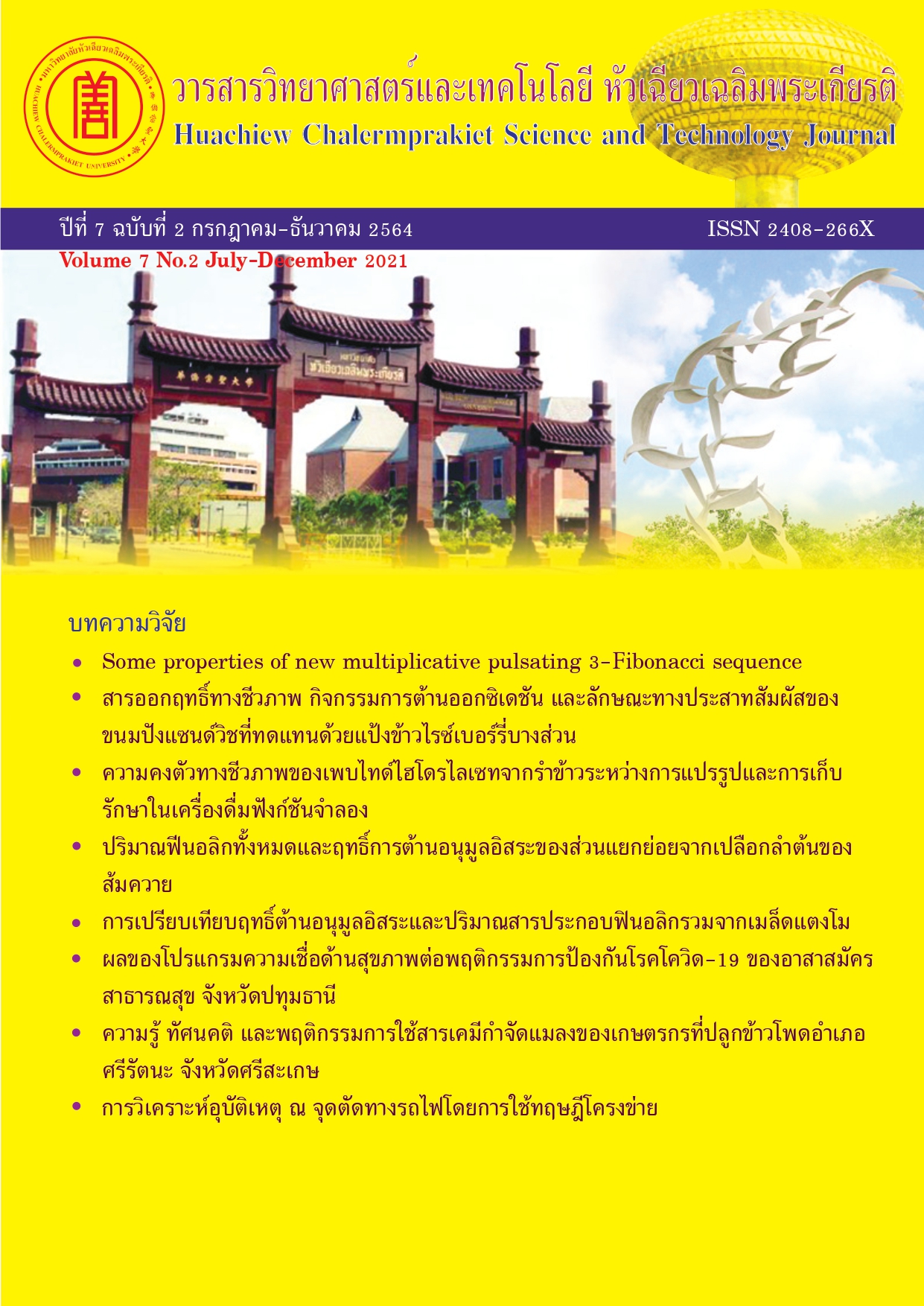ความคงตัวทางชีวภาพของเพปไทด์ไฮโดรไลเซทจากรำข้าวระหว่างการแปรรูปและการเก็บรักษาในเครื่องดื่มฟังก์ชันจำลอง
Bio-stability of peptide hydrolysate from rice bran during processing and storage in functional drink model
Keywords:
Rice bran, Peptide hydrolysate, Bio-stability, Free radical scavenging activity, Functional drink modelAbstract
The objective of this study is to investigate the bio-stability of peptide hydrolysate from rice bran in functional drink model subjected to different processing conditions, including addition of 0-15% (w/v) sugar, pH 3.5-7.0, moderate heat treatment of pasteurization at 63ºC for 30 min and severe heat treatment of sterilization at 121ºC for 15 min. The bio-stability during storage at 5ºC for 28 days was also evaluated. The increases in sugar contents in the formulations and heat treatment resulted in the significant increases in total phenolic content (TPC), DPPH antioxidant activity and ferric reducing antioxidant power (FRAP) (p≤0.05). Considering only samples with sugar addition, TPC, DPPH antioxidant activity and FRAP of functional drink model decreased significantly with higher pH (p ≤ 0.05). Pasteurization had no significant effect on TPC, DPPH antioxidant activity and FRAP, regardless of pH levels between 3.5 and 7.0 while those without sugar addition and having pH between 3.5 and 4.5 tended to have lower DPPH antioxidant activity after sterilization. No significant losses of TPC, DPPH antioxidant activity and FRAP throughout the 28 days of storage at 5ºC. The results suggested that the peptide hydrolysate from defatted rice bran had high bio-stability during both processing and storage and it can be used as functional ingredient in food products thereby enriching them with bioactive compounds.
References
ผู้จัดการออนไลน์. กรุงไทยแนะโอกาสทอง SMEs ชี้ ธุรกิจ Functional Foods กำลังรุ่ง. [อินเตอร์เน็ต]. 2564 [เข้าถึงเมื่อ 22 มี.ค. 2564]. เข้าถึงได้จาก: https://mgronline.com/stockmarket/detail/9620000033492
Ghribi AM, Sila A, Przybylski R, Nedjar-Arroume N, Makhlouf I, Blecker C, et al. Purification and Identification of novel antioxidant peptides from enzymatic hydrolysate of Chickpea (Cicer arietinum L.) protein concentrate. J Funct Foods 2015;12:516-25.
Kannan A, Hettiarachchy N, Narayan S. Colon and breast anti-cancer effects of peptide hydrolysates derived from rice bran. Open Bioact Compd J 2009;2:17-20.
Phantuwong N. Functional and biological properties of Sang Yod rice bran hydrolysate prepared by enzymatic hydrolysis and its application in rice pudding product. Ph.D. Thesis, Prince of Songkla University. Songkla; 2017.
Xu Z, Mao TM, Huang L, Yu ZC, Yin B, Chen ML, et al. Purification and identification immunomodulatory peptide from rice protein hydrolysates. Food Agric Immunol 2019;30(1):150-62.
Yimit D, Hoxur P, Amat N, Uchikawa K, Yamaguchi N. Effects of soybean peptide on immune function, brain function, and neurochemistry in healthy volunteers. Nutr 2012;28(2):154-9.
ศุภวรรณ ถาวรชินสมบัติ, ทิพย์สุดา เทพภูเขียว. ความคงตัวของไบโอแอคทีฟจากรำข้าวในเครื่องดื่มจำลอง. รายงานการวิจัยฉบับสมบูรณ์ ภาควิชาเทคโนโลยีอาหาร คณะเทคโนโลยี มหาวิทยาลัยขอนแก่น. ขอนแก่น: มหาวิทยาลัยขอนแก่น; 2554.
Singh BP, Vij S. In vitro stability of bioactive peptides derived from fermented soy milk against heat treatment, pH and gastrointestinal enzymes. LWT- Food Sci Technol 2018;91:303-7.
Liu Y, Wan S, Liu J, Zou Y, Liao S. Aantioxidant activity and stability study of peptides from enzymatically hydrolysate male silkmoth. J Food Process Preserv 2016;0(0):1-10.
Zhu CZ, Zhang WG, Kang ZL, Zhou GH, Xu XL. Stability of an antioxidant peptide extracted from Jinhua ham. Meat Sci 2014;96:783-9.
Lopez-Sanchez J, Ponce-Alquicira E, Pedroza-Islas R, de la Pena-Dıaz A, Soriano-Santos J. Effects of heat and pH treatments and in vitro digestion on the biological activity of protein hydrolysates of Amaranthus hypochondriacus L. grain. J Food Sci Technol 2016;53(12):4298-4307.
Wang X, Yu H, Xing R, Chen X, Liu S, Li P. Optimization of the extraction and stability of antioxidative peptides from mackerel (Pneumatophorus japonicus) protein. Biomed Res Int 2017;0(0):1-14.
Khairallah MG. Stability and sensory properties of rice bran peptide fraction incorporated orange juice. Theses and Dissertations, University of Arkansas. Fayetteville; 2009.
Rao Q, Kamdar AK, Labuza TP. Storage stability of food protein hydrolysates - A review. Crit Rev Food Sci Nutr 2015;0(0):1-24.
กุลรภัส วชิรศิริ, โศรดา วัลภา, มณีรัตน์ มีพลอย, ดำรงชัย สิทธิสำอางค์, ยุทธศักดิ์ สุบการี. ผลของปริมาณรำข้าวและเอนไซม์อัลคาเลสต่อระดับการย่อยโปรตีน ผลผลิต และฤทธิ์ทางชีวภาพในการกำจัดอนุมูลอิสระของเพปไทด์ไฮโดรไลเซทจากรำข้าวสกัดน้ำมัน. วารสารวิจัยแลพัฒนา มจธ. 2564;44(3):427-442.
Thamnarathip P, Jangchud K, Nitisinprasert S, Vardhanabhuti B. Identification of peptide molecular weight from rice bran protein hydrolysate with high antioxidant activity. J Cereal Sci 2016;69:329-35.
Chen GT, Zhao L, Zhao LY, Cong T, Bao SF. In vitro study on antioxidant activities of peanut protein hydrolysate. J Sci Food Agric 2007;87:357-62.
Kchaou H, Benbettaieb N, Jridia M, Nasria M, Debeaufort F. Influence of Maillard reaction and temperature on functional, structure and bioactive properties of fish gelatin films. Food Hydrocoll 2019;97(105196):1-14.
Karseno K, Wuryatmo E, Yanto T, Setyowati R, Haryanti P. Effect of pH and temperature on browning intensity of coconut sugar and its antioxidant activity. Food Res 2018;2(1):32-38.
Manzocco L, Calligaris S, Mastrocola D, Nicoli MC, Lerici CR. Review of nonenzymatic browning and antioxidant capacity in processed foods. Trends Food Sci Technol 2001;11:340-6.
Zhang C, Zhang N, Li Z, Tian Y, Zhang L, Zhang B. Stability of antioxidant peptides prepared from large yellow croaker (Pseudosciaena crocea). Curr Top Nutraceutical Res 2016;14(1):37-48.
Ward BP, Ottaway NL, Perez-Tilve D, Ma D, Gelfanov VM, Tschop MH, et al. Peptide lipidation stabilizes structure to enhance biological function. Mol Metab 2013;2:468-79.
Kang N, Song H, Zhang W, Zhao J, Zhang M, Xiong W, et al. Effect of substrate ratios and the species of sugar on the antioxidant activity of glycosylated products of the rana debris collagen peptide. E3S Web Conf 2019;78(02006):2-7.
Fu Y, Young JF, Dalsgaard TK, Therkildsen M. Separation of angiotensin I-converting enzyme inhibitory peptides from bovine connective tissue and their stability towards temperature, pH and digestive enzymes. Int J Food Sci Technol 2015;50:1234-43.
Downloads
Published
How to Cite
Issue
Section
License
บทความทุกบทความที่ได้รับการตีพิมพ์ถือเป็นลิขสิทธิ์ของ คณะวิทยาศาสตร์แฟละเทคโนโลยี มหาวิทยาลัยหัวเฉียวเฉลิมพระเกียรติ



